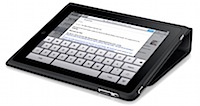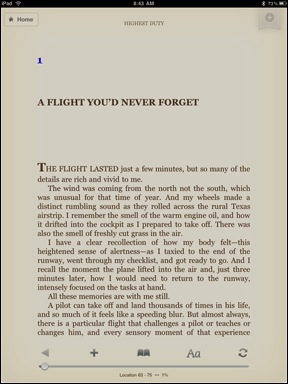I am loving my new iPhone.
When the Verizon iPhone became available earlier this month, I bought one. I was due for a phone upgrade anyway, and had to choose between an iPhone and an Android phone. I needed either operating system to use my Square point of sale device.
It had been nearly four years since the original iPhone was released, but for that for years, it was only available on AT&T. AT&T does not have the coverage I need in the places I go. It also has crappy customer service handled by overseas, outsourced workers. No matter how much I wanted an iPhone, I was not willing to enter into a relationship with AT&T. Instead, during the four years, I had a Palm Treo phone followed by a BlackBerry Storm. They did the job and I was satisfied.
I was eligible for a phone upgrade on December 22. The rumors of iPhone coming to Verizon were running wild before that. I held off long enough to hear the announcement before locking for two years in on a new phone.
Early in February, when I logged into my Verizon Wireless account, Verizon offered me the phone. Again, my choices were between an iPhone and an Android phone. The main reason I went with the iPhone was because there would be no learning curve for me. I already had an iPad and my understanding was that the operating system was nearly identical on the iPhone. Unlike many people, I don’t consider my phone and toy. It’s a tool. A communication tool. Smartphone features also make it a simple computing tool. I don’t play games, I don’t make movies, and I don’t waste a lot of time with apps. My main concern was getting a smartphone that met my communication needs and enabled me to sync my data with my computer. The way I saw it, the iPhone would do this easily and transparently while an Android phone would require me to either buy special software or jump through hoops using Google apps to sync my data. And although I wasn’t very interested in apps, I knew that there were far more iPhone apps than Android apps. When I discovered that the two phones I was considering, the iPhone and the Droid 2, would cost me the same to buy, the decision became a no-brainer. I bought the iPhone.

The last photo I snapped with my BlackBerry Storm. Really.
What I never realized, was just how much I would enjoy using the iPhone. It really is easier for me to use than any other phone I’ve ever had. The interface is very intuitive. But what really blew me away was how easy it was to sync my data between my Macs and my phone. I simply entered some information about my MobileMe account into my iPhone and my iPhone did the rest. Saving time saves money — really. If I’m not wasting time with a steep learning curve, I have more time available to get work done and to enjoy my life. For me, that’s what it’s all about.
The wide availability of apps surprised me. I never realized how many apps there were for things that I need to do. In my role as a pilot, I need specialized information about the weather, sunrise and sunset times, light angles, and FAA regulations. It wasn’t long before I found apps that can meet many of my needs. For example, I found an app that gets official airport weather and displays it in a format that’s familiar to me. This makes it possible for me to use my phone to get up-to-date weather information about any airport that I might need to fly to. I can even do this during flight (although I can’t say I recommend doing so). Another app not only makes it easy to create an official FAA flight plan but it will show my aircraft position on an aeronautical chart while I am flying. Another app makes it easy for me to log my flight time after every flight. I can then sync that data to a file on my Mac book Pro and my iPad so I have up-to-date logbook information in multiple places.
I know there are a lot of games out there, but I don’t play them. I keep hearing about Angry Birds and how addictive it is and can’t understand why someone would want to play a game that sucks so much time out of their life. The only reason Game Center is on my iPhone is because I can’t get it off. There are no games. People told me that I would like my iPhone because I play with it, but that simply isn’t true –– not in the true sense of the word. I may spend more time browsing weather information and reading books and articles on the news but I don’t play games.
I’m not saying the iPhone is the perfect phone for everyone. It really depends on your needs. If you like to spend your time watching video on your phone, you probably would prefer something on a faster, 4G network. If you’re only interested in communication, you could probably save a lot of money by going with a standard phone instead of a smartphone. People who buy iPhones to look cool or keep up with their friends are idiots. The phone should meet your needs. If it exceeds your needs it should only do so to give you room to grow. After all, don’t you want your phone to last two years?
I’ll be writing a lot about my iPhone in the days and weeks to come. I want to highlight some apps that I think people may find useful. I don’t want people thinking that I’m an Apple fan boy or fan girl. Although I like most Apple products, I’m not blind to their shortcomings. (I must admit, however, that I haven’t found any shortcomings in my iPhone yet.) My goal is to point out how software tools, including mobile computing apps, make my life easier. By sharing this information with you, you might learn how to make your life easier, too.
On a side note here, I’m currently experimenting with Dragon Dictate, a software program that uses voice recognition to transcribe what I dictate. This entire blog post was written by dictation. As I look over what has been transcribed, I realize that it is not error-free, but it is amazingly accurate. I need to learn the software to help make me more productive. Many people like to spend hours in front of the computer but I don’t. I’m hoping that by using dictation software which can type almost as fast as I speak, I can save a lot of time in my writing work and be able to spend more time doing the things I love with the people I love.

 This morning, I went online to the Verizon site. When I logged in, I was greeted with a message telling me that as a “valued customer,” I was eligible to upgrade to an iPhone first and could get the phone as soon as February 10. I followed a trail of information by clicking a bunch of buttons. I was surprised that the 16GB iPhone 4 would cost me the same as the Droid 2. I clicked some more. I was surprised that an unlimited voice/text plan was available. And that adding up the plans I needed would cost me less per month than I was already paying with my 2-year-old BlackBerry Storm.
This morning, I went online to the Verizon site. When I logged in, I was greeted with a message telling me that as a “valued customer,” I was eligible to upgrade to an iPhone first and could get the phone as soon as February 10. I followed a trail of information by clicking a bunch of buttons. I was surprised that the 16GB iPhone 4 would cost me the same as the Droid 2. I clicked some more. I was surprised that an unlimited voice/text plan was available. And that adding up the plans I needed would cost me less per month than I was already paying with my 2-year-old BlackBerry Storm. Last week, while I was away in Ventura, CA, recording a revision to my Twitter course for
Last week, while I was away in Ventura, CA, recording a revision to my Twitter course for  Apple Case. Frankly, I can’t understand why so many third party vendors are creating and selling cases for this device. The plain black case Apple offers (at a whopping $49) is excellent. It provides the protection you need for your iPad investment without making a slim, portable device unnecessarily bulky. And since the cover can be used to prop up the iPad at an angle in landscape view, it does double duty. Now that I’ve slipped my iPad into it, I can’t imagine the need for anything else.
Apple Case. Frankly, I can’t understand why so many third party vendors are creating and selling cases for this device. The plain black case Apple offers (at a whopping $49) is excellent. It provides the protection you need for your iPad investment without making a slim, portable device unnecessarily bulky. And since the cover can be used to prop up the iPad at an angle in landscape view, it does double duty. Now that I’ve slipped my iPad into it, I can’t imagine the need for anything else. Kindle vs. iBooks. I think Apple missed the boat on this one. The Kindle app (see screenshot) has iBooks beat. Why? Because the Kindle app is available for iPad, iPhone, BlackBerry, Mac OS, Windows, etc. iBooks is available on iPad. So I go to Amazon.com and I buy a book. That book is automatically available on all of my registered devices. My bookmarks and last page read are automatically synchronized among them. So I can read a book in bed on my iPad and then, the next day, when I’m stuck waiting in line at the Motor Vehicle office, I can whip out my BlackBerry and continue reading where I left off. Theoretically, I can also register my husband’s Windows laptop so he can read my books, too. The only thing that would make this better is the ability to loan books to other Amazon.com account holders like Barnes and Noble’s Nook. (By the way, I named my iPad “Not Nook” because I cancelled my Nook order in January, expecting to buy an iPad instead. B&N dropped the ball when they couldn’t fulfill orders in a timely manner. Not having a problem doing that anymore, I bet.)
Kindle vs. iBooks. I think Apple missed the boat on this one. The Kindle app (see screenshot) has iBooks beat. Why? Because the Kindle app is available for iPad, iPhone, BlackBerry, Mac OS, Windows, etc. iBooks is available on iPad. So I go to Amazon.com and I buy a book. That book is automatically available on all of my registered devices. My bookmarks and last page read are automatically synchronized among them. So I can read a book in bed on my iPad and then, the next day, when I’m stuck waiting in line at the Motor Vehicle office, I can whip out my BlackBerry and continue reading where I left off. Theoretically, I can also register my husband’s Windows laptop so he can read my books, too. The only thing that would make this better is the ability to loan books to other Amazon.com account holders like Barnes and Noble’s Nook. (By the way, I named my iPad “Not Nook” because I cancelled my Nook order in January, expecting to buy an iPad instead. B&N dropped the ball when they couldn’t fulfill orders in a timely manner. Not having a problem doing that anymore, I bet.) Flash. Okay, so the iPad doesn’t support Flash. I don’t care very much because I hate Flash. I hate the way it’s overused on the Web, I hate the way it takes so damn long to load on the shitty slow Internet connection in my Wickenburg office, I hate the way when it finally loads that it wastes time and bandwidth with idiotic content. Take, for example, the crappy design of
Flash. Okay, so the iPad doesn’t support Flash. I don’t care very much because I hate Flash. I hate the way it’s overused on the Web, I hate the way it takes so damn long to load on the shitty slow Internet connection in my Wickenburg office, I hate the way when it finally loads that it wastes time and bandwidth with idiotic content. Take, for example, the crappy design of